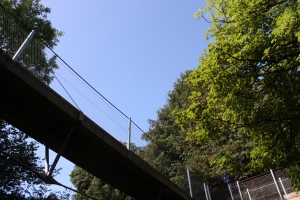The Lough Key Forest Park has been developed in recent years into an activity centre consisting of the Lough Key Experience, Boda Borg and Adventure Kingdom. Part of the Lough Key Experience is a 300 metre long tree canopy walk that brings you through part of the forest, 9 metres above the ground. The tree-top walk emerges at the waters edge, just next to the Waterways Ireland mooring facilities, where there are excellent views across the lake to Castle Island.
Another interesting part of the ‘experience’ are the 19th century tunnels which lead out to the Moylurg Viewing Tower. The Tower stands in the place of Rockingham House, which was designed by the architect John Nash in 1809. The house was destroyed by fire in 1957, and the surviving walls were demolished in 1971. The viewing tower was built in 1973, and although it provides some beautiful panoramas of the lake and the park, personally I find the tower quite ugly and imposing. The bottom of the tower sits in the basement area of the house, where the servants’ quarters would have been, and the underground passages that lead to the harbour and the turf quay.
Trinity Island lies offshore to the west of Castle Island, just beyond Drummans Island. The MacDermot family gave the 2 acre island to the White Canons of St. Francis in the 13th century, where they remained until the suppression of the monasteries in the 17th century. The White Canons belonged to the Premonstratensian Order, which was founded by St Norbert at Prémontré Abbey, near Laon in north-eastern France in 1120. Their name stemmed from the white colour of their habits. They began construction of Holy Trinity Abbey soon after the MacDermots granted the land to them in 1220. The Abbey was constructed from the local rocks found around Lough Key, such as pale-grey sandstone and limestone which are found on the southern shore. The Annals of Loch Cé, which cover the period between 1014 and 1590, were written on Trinity Island. There is a tomb on the island where the body of Úna Bhán MacDermot lies. She was the daughter of the Chief Brian Óg MacDermot who refused permission for her to marry Tomás Láidir Costello, the son of one of his enemies. She is said to have died of a broken heart, and Tomás swam across to the island every night to weep by her graveside. When Tomás died not long after Úna, her father allowed Tomás to be buried by the side of his love.
On the southern shore of the lake, close to the Forest Park Visitor’s Centre, lies a small stone harbour. From here we can see the ruins of a castle on a little island just off-shore. This is the aptly named Castle Island, which is recorded in the Annals of Loch Cé in the 12th century. At that time the area was called Moylurg and it was ruled by the MacDermots, who resided on Castle Island and at the site of the Moylurg Tower until the 17th century. The MacDermot residence on the island was actually a fortress called ‘Carraic Locha Cé’ or the Rock of Lough Key. Under Cromwell the MacDermot lands were given to the English King family, who renamed Moylurg as Rockingham. The Kings rebuilt the castle on Castle Island as a folly, which they used as guest accommodation until it was badly damaged by fire.


